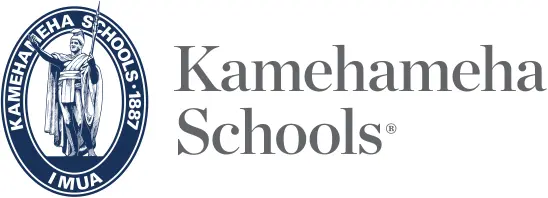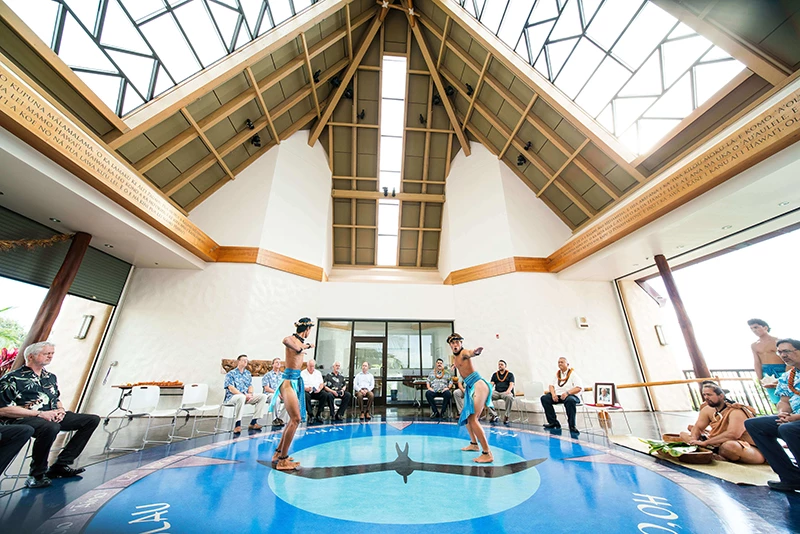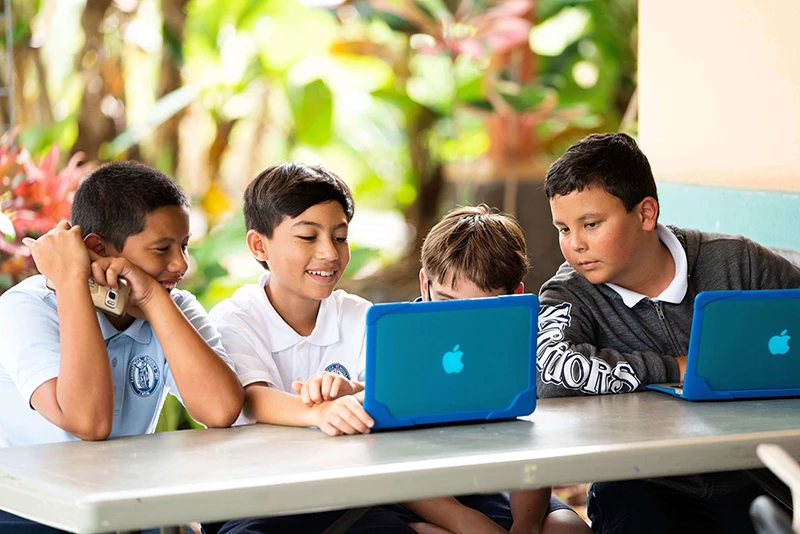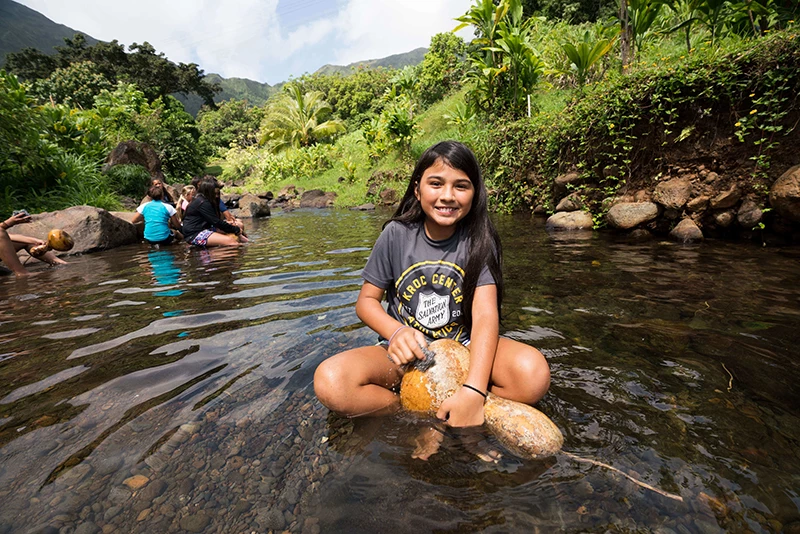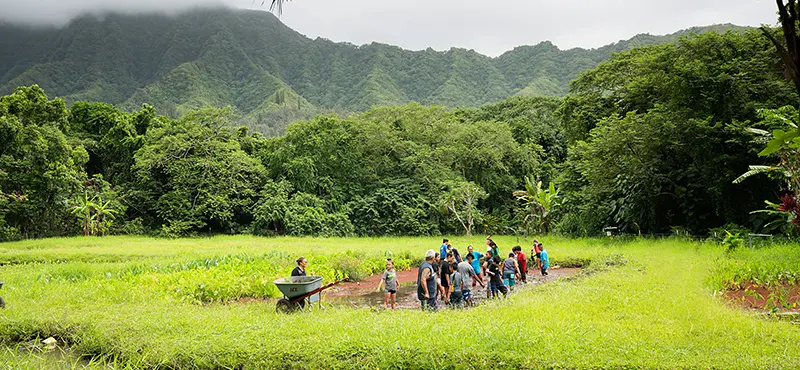March 24, 2025

This mo‘olelo first appeared in I Mua magazine. Read the full issue.
Story
Justin Barfield
Photos
Jacob Chinn
I ka wā ma mua, ka wā ma hope — In the past, the future is found. This ‘ōlelo no‘eau is a thread that runs through many crucial conversations happening right now — rebuilding Lahaina, restoring ‘āina and wai, and reclaiming Hawaiian history, language and culture suppressed for far too long.
Unlikely as it may seem, a group of KS Kapālama sixth graders managed to encapsulate all these weighty issues — and solutions too — as they delivered a rousing final performance of the play “Ka Malu ‘Ulu o Lele” at Baldwin High School in Wailuku on Aug. 10, 2024.
Spontaneous shouts of “Eō!” and thunderous applause filled the auditorium, and a good many tears were shed as the crowd of nearly 1,000 took in the mana‘o and mele delivered so masterfully by nearly 150 haumāna ‘ōpio.
Pā‘ele Kiakona KSH’13, who is a lāhui advocate and alaka‘i in the Lahaina Strong movement, offered this take after the show: “All of our people need to see this. There are so many things that were shared here that a lot of our people don’t even know about. And I think having keiki say it to you, it kind of gives you that fire within you, like, damn, I need to go and start learning more of this and get deeper embedded into our culture and our people and our history.”
To understand how this performance ended up becoming one of Maui County’s official remembrance events to mark one year since the devastating wildfires, it’s important to go back to the play’s origins on the Kapālama kula ha‘aha‘a campus back in August 2023. The kumu who spearheaded the annual fifth grade play were in the early stages of mapping out a production focused on ho‘okele when the devastating fires happened. As the pae ‘āina grieved, nā kumu K. Ke‘ala Tamashiro Sharrer KSK’95 and Mara Bacon-Chang KSK’87 and the entire performing arts hui pivoted to the concept of creating a “love letter to Lahaina.”
“Music heals, the performing arts heals,” Bacon-Chang said. Sharrer added: “We are all the same, and we’re one lāhui. We wanted to make sure they know that we are in it with them.”
Over the following months, kumu and haumāna alike took a deep dive into Lahaina’s history and the issues that turned it from a lush breadbasket to ‘āina wela in less than two centuries. They consulted community leaders and did research while writing scripts and catchy lyrics.
Sixth grader Waihiowaioha Alo explains the meaning behind the play’s inoa: “Ka Malu ‘Ulu o Lele means the shaded breadfruit grove of Lele. Lahaina was originally called Lele, which used to have a bunch of ‘ulu trees which created its own microclimate, keeping it cool. Much different than the hot, dry West Maui we have today.”
For those not ma‘a to Kapālama’s fifth grade play, it’s become quite the rite of passage. Like Song Contest, all haumāna take part. The level of production and sophistication is extraordinary, especially when you realize the performers are between the tender ages of 9 and 11!
“When people hear fifth grade play, they often think of a production that is in the cafeteria. This is something that could easily be at the Blaisdell Concert Hall and maybe on an even bigger stage,” said Kamuela Binkie, a Maui native and the elementary school’s campus student support services director.
Originating in 1992, the play has undergone a significant transformation since its early days. Long gone are performances about Lewis and Clark, “Home of the Brave” or “Schoolhouse Rock.” For Bacon-Chang and Sharrer, the huliau started around 2007, but reached another level in 2016 after completing the Aloha ‘Āina Master’s Cohort through the University of Hawai‘i. One of their kumu? J. Noelani Goodyear-Ka‘ōpua KSK’92, who now serves on Kamehameha Schools’ Board of Trustees.
“After taking that aloha ‘āina master’s class, for Mara and I ... it was like we’re not afraid to talk about those things that are important or that might be edgy, because it’s our kuleana. If we don’t teach our haumāna about it, we are really doing a disservice to them,” Sharrer said.
Bacon-Chang also added: “HCBE (Hawaiian Culture-Based Education) and the E Ola! graduate has really opened the doors for us to explore topics that we wouldn’t have in the past.”
In the years since, fifth grade kumu and haumāna have delved deeply into lāhui-focused issues such as wai and Kapūkakī (Red Hill), the Moananuiākea worldwide voyage and Pu‘uloa (Pearl Harbor).
Their latest creation, “Ka Malu ‘Ulu o Lele” is clever, sophisticated and downright catchy. Haumāna plead for restoration of wai and ‘āina singing “Hulihia” to the tune of “Believer” by Imagine Dragons. They bemoan the influence of bawdy whale boat sailors to the tune of Miley Cyrus’ “Party in the U.S.A.” (“No Party in Lahaina Bay”), and celebrate the kānaka behind the first print house west of the Mississippi at Lahainaluna to the tune of the Commodores “Brick House” (“oh it’s a print ... house”).
When it came time to perform the play in front of mākua and ‘ohana in spring 2024, it was clear something extraordinary had been created. Successful performances on the Kapālama campus led to a pair of special performances on Maui. The play touched so many on Maui during those performances, the community members worked behind the scenes to have them come back to the Valley Isle to be part of the anniversary commemoration events in August 2024.
Now sixth graders, haumāna who worked through the summer re-doing props and reacquainting themselves with their lines and dance moves made the huaka‘i back to Maui on Aug. 10, most aboard a chartered flight due to the group’s size.
The performance itself was magical. Behind the scenes, haumāna and kumu made adjustments on the fly whenever something unexpected came up (with the audience none the wiser). On stage, they delivered an energetic two-hour performance that riveted the crowd.
Possibly the most memorable moment occurred when haumāna sang Lahainaluna High School’s alma mater. The crowd stood up, many singing in unison with the haumāna. A true chicken skin moment.
When it’s all said and done, the fifth grade play means many things to many people. Monica Loui KSK’77, whose ‘ohana’s property sustained damage in the Kula wildfire on Aug. 8, 2023, says these haumāna exemplify the ideals Ke Ali‘i Pauahi fought for.
“I think she would be extremely proud that her pua are very empathetic, sympathetic and are demonstrating a lot of kindness to the wider community.”
Community leader Pā‘ele Kiakona lauded the mana behind the heavy use of ‘ōlelo Hawai‘i throughout the play. His mana‘o echoes a question posed during the play: “If we don’t share our own mo‘olelo, who will?”
“You know the people who came to Hawai‘i tried to snuff that out, because there was power in that. Because once you make people forget their language … they forget their culture. They forget their culture, they forget their history. They forget their history, they forget who they are. They forget who they are, they forget what they’re even fighting for. So why fight? Now we are able to slowly reclaim all of that, especially our language,” Kiakona said.
Kumu see the play’s impact in how it shapes the future of haumāna.
“There are significant points which mark time. The fifth grade play is one of those. When you talk to them as upperclassmen in high school and you ask them how did they form their Native Hawaiian identity?, a lot of them go back to these very formative experiences that they had in the younger grades,” Binkie said.
Kumu Sharrer brings it back to where it all started: I ka wā ma mua, ka wā ma hope — In the past, the future is found.
“We hope that by them learning about these things that are important to our lāhui, it’s planting that seed within them to be kia‘i later. As they leave us and become ‘ōiwi leaders out there in the world, that in some small way, we planted this little seed within them.”
Watch their full performance on Youtube.

